Car Shipping Tips
Is terminal-to-terminal car shipping worth it?

Written by:
WeShipCarsPublished on
•
30 min read
Here at WeShipCars, we sometimes get asked about terminal-to-terminal car shipping, so we thought we’d create a guide to answer all your questions. With all the information close at hand, plus our own expert opinion, you’ll be able to decide for yourself if terminal-to-terminal auto shipping is worth it.
What is terminal-to-terminal car shipping?
Terminal-to-terminal car shipping is an auto transport method for moving a vehicle across the country. Basically, you drop your car off at a terminal location and a carrier or carriers transport it to another terminal where you pick it up.
Car shipping via terminal-to-terminal used to be the go-to method for shipping cars across the US, but more recently, the auto transport industry has evolved into providing more door-to-door services.
Ready to ship?
Your journey starts here:
How does terminal-to-terminal auto transport work?
Terminal-to-terminal auto transport is straightforward, but you need to get more involved than if you choose door-to-door auto transport. Customers drop their vehicles at a designated terminal and pick them up from another terminal when they arrive. Many people consider it to be a more affordable option, but there are hidden costs and inconveniences you should consider.
Let’s take a closer look at the terminal-to-terminal car transport process:
- Drop off your vehicle: Once you’ve booked your service, you receive instructions on where to drop off your vehicle. It could be near your home, but you may have to travel a considerable distance. A shipper's terminal could be a large outdoor parking lot or storage facility. It’s where vehicles are stored waiting for shipment. Before you drop off your vehicle, inspect it carefully for any existing issues.
- Loading and transit: Your vehicle will stay at the terminal until the carrier is ready to leave. It might be stored for less than 24 hours, but it could be stored for longer. Depending on your selected service, your vehicle travels in an open or enclosed trailer during transit.
- Picking up your vehicle: When it arrives at the destination automobile terminal, the carrier notifies you when and where to pick it up. You might have to travel a distance to collect your vehicle, but you can do it at your convenience. However, keep in mind that there may be storage fees to pay if you don't collect it within a specified time.
Terminal-to-terminal car transport vs door-to-door:
Selecting the best option for your vehicle’s delivery is essential to the shipping process. Would you prefer the lower prices of car transport via terminal-to-terminal or the convenience of booking door-to-door car shipping? Understanding the difference between these options makes your decision easier.
What is door-to-door auto transport?
With door-to-door transport, your car is collected from your preferred location, which for many people is right outside their door. The carrier then takes it to your preferred destination. It could be your residence, place of business, or any other location.
With this method, you don’t need to drop off or pick up your vehicle from a terminal, which means you benefit from a seamless and hassle-free experience.
Door-to-door auto transport is typically more expensive than terminal-to-terminal car transport because it requires additional time, resources, and service personalization.
Terminal-to-terminal auto transport:
- Drop-off/ pick-up: At a car shipping terminal
- Convenience: Less convenient
- Cost: Significant cost savings
- Flexibility: More flexible
- Best for: People who want to save money
Door-to-door car shipping:
- Drop-off/ pick-up: At your home or another location of your choosing
- Convenience: Very convenient
- Cost: Usually more expensive
- Flexibility: Must be available at your door
- Best for: People who want maximum convenience and a safer, more risk-free option
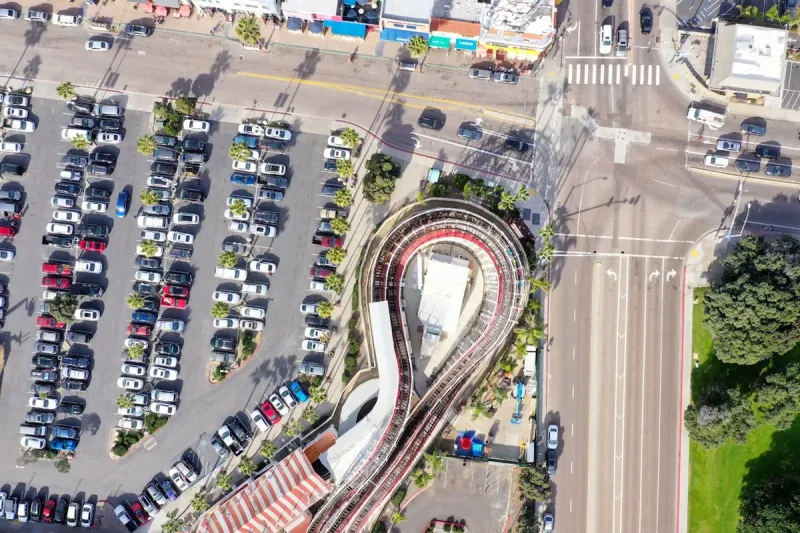
Pros of terminal-to-terminal car shipping
Terminal-to-terminal car shipping offers numerous advantages to customers. The main benefits of this service include:
- Cost-effective: Car transport via terminal-to-terminal services tends to be cheaper than door-to-door services. The carrier saves time and fuel by removing the need to navigate individual pick-up or drop-off locations. Rather than driving through neighborhoods or making multiple stops, the carrier loads and unloads vehicles at a centralized shippers terminal. This streamlining of operations, reduced mileage, and lower fuel and labor costs ultimately translates to savings for the customer.
- Flexibility: Terminal-to-terminal car transport lets you drop off or collect your vehicle when it suits you. A terminal for car shipping may open with extended business hours, making it more convenient.
- Secure storage: Automobile terminals are designed with vehicle safety in mind. Cars are generally stored in gated, monitored lots until customers pick them up.
- Lesser impact on the environment: Consolidating multiple vehicle shipments at a terminal for car shipping allows carriers to plan more efficient routes and reduce fuel consumption.
- Available in major cities with regional terminals: Most services operate through a network of terminals in large metro areas, making them readily accessible for urban customers.
- Strategic locations: Terminals are typically near transport hubs, highways, or logistics centers. This strategic placement makes it easier for carriers to manage vehicle loads and delivery schedules.
- Ideal for non-urgent auto shipping: Terminal car shipping is perfect if your schedule is flexible. It’s a reliable, lower-cost option for those who don’t need expedited auto transport and prefer to coordinate around a convenient time.
Ready to ship?
Your journey starts here:
Cons of terminal-to-terminal car shipping
There are some very good reasons why terminal-to-terminal auto shipping is not as popular as it once was. The disadvantages of this shipping service include:
- Added effort: Unlike door-to-door shipping, you must deliver your vehicle to a terminal location and collect it when it arrives. These extra steps require effort rather than waiting for a carrier to collect and deliver your car.
- Limited terminal locations: Car transport terminal-to-terminal services aren’t available everywhere. If you live in a rural area or a smaller town, the nearest terminal for drop-off or pick-up could be hours away, making it inconvenient and impractical.
- Additional transportation: You’ll likely need a ride to or from the shipper's terminal. Whether you book a taxi, arrange a lift, or rent a car, these added transportation needs can increase cost and hassle.
- Potential delays: Terminal-to-terminal auto transport often means your car sits at a terminal waiting to be loaded with other vehicles. This can cause delays, especially if the carrier waits to fill a truck before dispatching.
- Time-consuming: The additional wait time can mean terminal-to-terminal car transport takes longer than door-to-door auto transport.
- Potential risks: Automobile terminals are generally secure; however, vehicles may be stored for long periods in open lots. This increases exposure to weather or minor wear and tear, especially if the location experiences high traffic.
- Hidden costs: The initial upfront cost of terminal-to-terminal auto shipping is typically cheaper, but some terminals charge daily storage fees if you don’t pick up your vehicle within a specific time frame. These costs can quickly add up if you’re delayed.
- Accessibility issues: Some terminals are located in industrial or remote areas and are not easily reachable by public transport. Without a way to get there, dropping off or collecting your vehicle can be challenging.
- Limited transport options: Terminal-to-terminal car shippers tend not to offer enclosed car shipping, an auto transport service that’s recommended for high-value, custom, antique, exotic, or luxury cars.
- Less personalized: Terminal-to-terminal car transport is a more impersonal process. You’re less likely to speak directly with the carrier, and terminal staff manage the handoff of your vehicle, rather than the person driving the transport truck.
- Rigid timing: Some terminals operate during specific hours and may not be open on weekends. If you can’t coordinate your schedule to match, it could be inconvenient, or there will be late pick-up fees to pay.
- Storage fees: If you can’t collect your vehicle promptly from the automobile terminal, you may have to pay storage fees. These fees vary by location and can become expensive if you’re unexpectedly delayed.
- Limited control: Your vehicle is handled by multiple people across different locations, meaning you have less visibility. This lack of direct oversight can make some customers uneasy about using terminal-to-terminal auto transport.
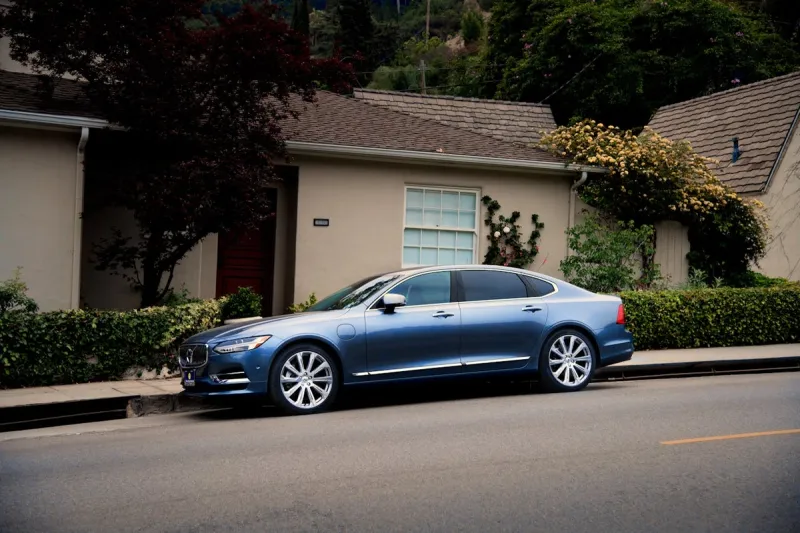
Pros of door-to-door car shipping
There are numerous advantages to using door-to-door auto transport. First, it’s very convenient because it simplifies the entire process, often provides cost-saving benefits when comparing the whole picture, and helps reduce vehicle wear and tear by reducing unnecessary mileage.
Let’s look at some of the key benefits in more detail:
Saves time
Door-to-door shipping eliminates driving your car to a terminal for drop-off or pick-up. Instead, the carrier picks up and delivers your vehicle as close to your chosen addresses as is legal and safe to do so. This means you can focus on other parts of your move or travel plans without making extra trips to and from a car transport terminal.
Saves travel expenses
Replacing the trip to an automobile terminal with door-to-door car transport saves you money on fuel, tolls, parking, or even flights or taxi rides, especially if the nearest terminal is hours away. These savings can add up for busy individuals or those moving long distances.
Saves mileage and wear and tear
One of the most significant benefits of shipping your car door-to-door is keeping the miles off your odometer. Additionally, that reduces engine wear and tear, tire usage, and the risk of roadside breakdowns or accidents. Over time, such savings contribute to a higher resale value and fewer maintenance costs.
Reduces stress and risk
When your car is picked up and delivered directly, there’s less handling involved. You don’t have to worry about finding your way to an unfamiliar shippers terminal or leaving your car parked in a lot. Plus, there’s reduced exposure to theft or vandalism since your vehicle will spend less time unattended.
Re-registration is not necessary
When you drive your vehicle across state lines to a terminal, you may need to temporarily register it depending on local laws. With door-to-door auto transport, the car is transported on a carrier truck, so there’s no need to worry about interim registration, temporary tags, or navigating unfamiliar DMV rules.
Non-running vehicles can be shipped
Door-to-door services are well-equipped to handle non-operational vehicles. Carriers with winches or liftgates can load your car directly from your driveway or nearby street, something not all terminal-to-terminal auto shipping providers can accommodate. This option is ideal for project cars or damaged vehicles.
Cons of door-to-door car shipping
The downsides of booking door-to-door auto transport services are few and far between. But to help you decide which shipping method is best, let’s examine the cons of door-to-door shipping.
Higher cost
Rather than meeting the carrier at a terminal, along a major route, or in a high-demand area, the driver may have to go out of their way to collect and deliver your car. You’ll have to pay extra to cover the cost of fuel and the driver’s time.
Accessibility issues
Trucks and trailers that transport vehicles across the US are large and require space to maneuver. Local and small roads may prohibit such cars, leaving you to find a better location, like a wider road or a nearby parking lot. Low power lines and overhanging branches can also cause problems for the carrier.
Scheduling coordination
Door-to-door delivery often required both parties to be available for hand-off. If your schedule changes or the carrier is delayed, coordinating pick-up and drop-off times can be a hassle.
Longer delivery windows in rural areas
If you live far from a major city or highway, scheduling a carrier to come directly to you may take longer. This could delay your overall transport time compared to dropping your vehicle off at a central car shipping terminal.
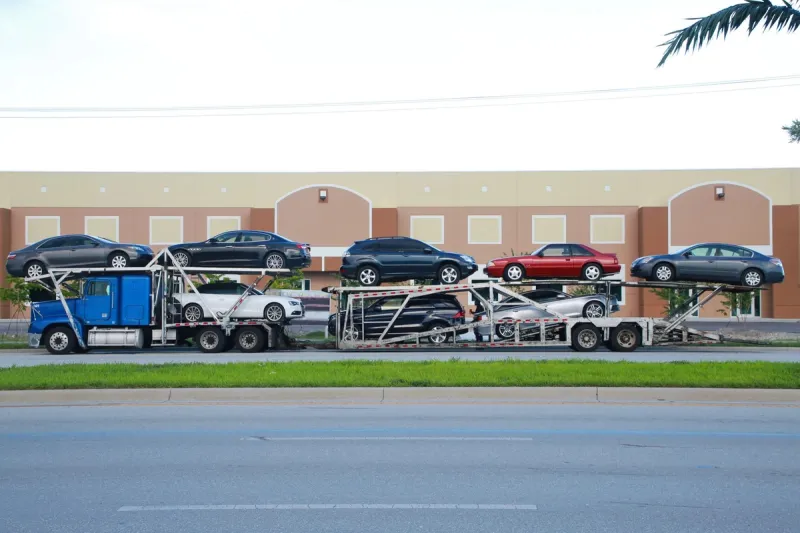
How does door-to-door auto transport work?
Door-to-door shipping is a simple process that WeShipCars helps you complete in three easy steps:
Step 1: Get a quote and book your order: Your first step is to get a quote and book your order. For your convenience, we have a free, instant online quote calculator. Provide some basic details, and car shipping quotes are available in seconds. Alternatively, call and speak directly with our car shipping experts or use the live chat option.
Step 2: We pick up your car: We’ll dispatch a fully insured, pre-screened carrier who collects your vehicle as close to your specified location as safety and local regulations allow.
Step 3: We deliver your car: The carrier reaches out in advance of their arrival to let you know they’re getting close to the drop-off point. Once you’ve inspected your vehicle to confirm its condition, you sign off to complete the delivery.
Ready to ship?
Your journey starts here:
Why choose door-to-door auto transport?
There are many reasons why you might want to ship your vehicle across the country. Perhaps you’re relocating, purchasing a car online, heading south for the winter, or heading off to college. Whatever the reason, door-to-door auto transport stands out as the best option for many reasons. For example:
- It’s the most convenient shipping method available: You don’t have to drive long distances, or navigate to a car shipping terminal, or arrange extra transportation. A carrier picks up and delivers your vehicle as close to your door as possible, saving you time and effort.
- It’s ideal if you’ve got a busy schedule: If your schedule is not flexible, door-to-door services give you the freedom to stay where you are and let the carrier come to you.
- It works for a wide range of vehicles: Door-to-door auto transport accommodates a wide range of shipping needs, from everyday cars to luxury models, non-running vehicles, and even motorcycles. There will also be the option of choosing between open car transport and enclosed car shipping, expedited auto transport, and guaranteed car pick-up services.
- There’s no additional handling. Because your car isn’t stored at a terminal or transferred between carriers, there's less chance of accidental damage, exposure to the weather, or unnecessary movement.
- It provides a stress-free experience: For major life transitions, such as a move or seasonal relocation, door-to-door transport removes one task from your to-do list, making the process easier to manage.
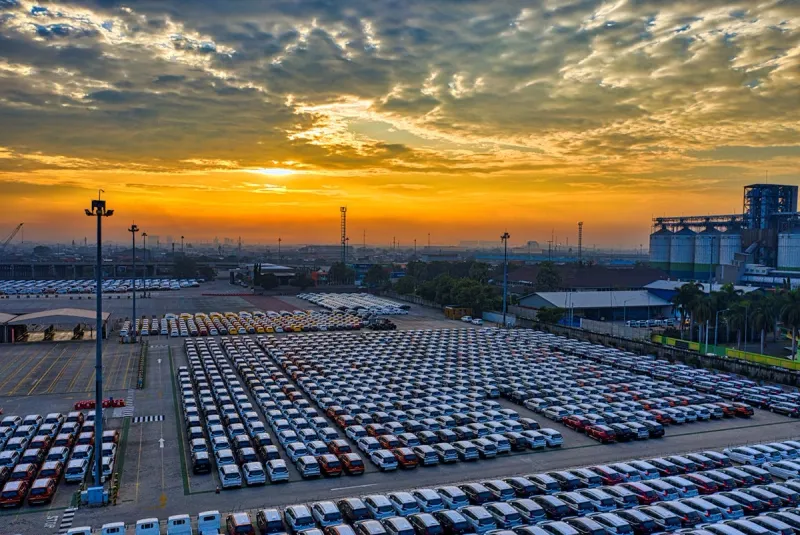
When is terminal-to-terminal auto shipping the best option?
Terminal-to-terminal auto shipping could be the best choice if you:
- Want to save money: The service is ideal for budget-conscious shippers who want a cost-effective shipping solution.
- Prefer the DIY touch: Perfect for people who are self-reliant and like some hands-on involvement.
- Need flexible timing: Great for people with variable schedules who need adaptable drop-off and pick-up times.
- Live in a remote area: Suitable for anyone moving to or from less accessible locations.
- Care about the environment: A greener choice that helps reduce overall fuel consumption.
The benefits of car transport terminal to terminal
Now that you’re aware of some of the instances when terminal-to-terminal transport is the best option, let’s highlight some of the benefits you can enjoy.
- Lower costs: Terminal-to-terminal car transport offers significant cost savings compared to door-to-door. This is because the carrier can avoid spending time and resources making pick-ups and deliveries to various locations. These savings can be passed on to the customer, leading to more affordable rates.
- Faster transit times: Bypassing the need for local trucks to transport your vehicle can speed up the shipping process. Terminal-to-terminal shipments are often direct routes between origin and destination terminals, which means fewer stops and quicker delivery.
- Increased security: Vehicles stored in a terminal are generally placed in a secure area. There might be surveillance cameras, and access is only granted to authorized personnel. This provides an extra layer of protection for your car during the shipping process.
- Easier to track shipments: You can track your shipment’s status more easily online or by contacting the terminal directly. You can closely monitor where your shipment is and when it's expected to arrive at its destination.
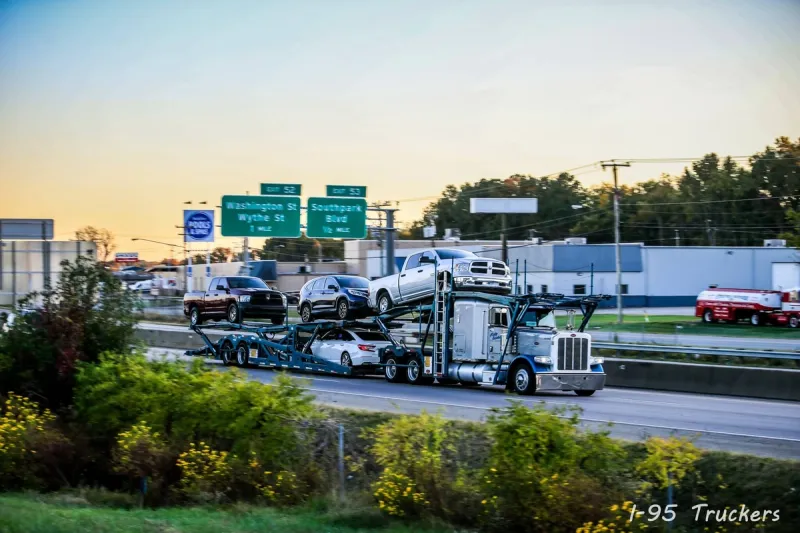
What factors affect the cost of terminal-to-terminal auto transport?
When it comes to auto transport, several factors influence the cost to ship a car. Knowing what these factors are helps you make an informed decision about what shipping method to use.
The main factors that affect the cost include:
- Distance: The greater the distance between the pick-up and delivery point, the higher the cost. Carriers typically charge by the mile, so a 1,000-mile journey will cost less than a 2,000-mile journey.
- Transport type: The method of transport you choose can also impact the overall cost. Enclosed car shipping is more expensive than open car transport, for example.
- Vehicle size and weight: Your vehicle's dimensions and weight affect its cost because larger and heavier vehicles require more space and fuel to transport. For example, it costs less to ship a compact car than a large pickup truck.
- Pick-up and delivery locations: Shipping to and from remote locations increases the overall cost due to the additional time and effort carriers have to make.
- Shipping time: Choosing expedited auto transport or guaranteed car pick-up services raises the price.
- Time of the year: Seasonality plays a big role in pricing. Demand for auto shipping purposes tends to spike during snowbird season and summer months, driving up prices. Ship your vehicles during the off-peak period, and it could reduce costs.
- Vehicle condition: If your car is inoperable and needs to be winched onto the carrier, you can expect to pay an additional fee.
- Fuel prices: The price of gas fluctuates, and these changes are reflected in the price of your auto transport service.
What costs are involved with a shipper's terminal?
Aside from the factors listed above, there’s something else to consider if you’re thinking about booking terminal-to-terminal auto shipping. There is an extra fee you might have to pay. Storage fees are charged daily, and you’re liable for these if you cannot pick up your car on time.
Typical terminal fees vary from $15 to $35 per day, depending on the location, with facilities near major metropolitan areas usually costing more. Over time, these can add up, which could offset any savings you make.
How long does car shipping terminal to terminal take?
The time it takes for terminal-to-terminal car shipping depends on several factors, including the distance between terminals, carrier availability, and seasonal demand. In general, cross-country shipments take anywhere from 5 to 12 days, with shorter trips completed in 2 to 7 days.
Unlike door-to-door shipping, terminal-to-terminal service may include additional waiting time before the vehicle is loaded onto a carrier. This is because carriers often wait until they have a full load at the shippers terminal before departing. If demand is low or the terminal is in a less active region, delays may occur.
Other factors that can affect how long does it take to ship a car include:
- Popularity of the route: Heavily traveled routes between major cities are often faster than rural or off-route locations.
- Carrier schedule: Some terminals have set schedules for when carriers depart, which can affect when your vehicle gets on the road.
- Weather: Severe weather can slow down delivery times, particularly during winter months or along routes prone to storms.
- Vehicle condition: If your vehicle isn’t working or needs special handling, it may take longer to organize transport.
Tips for saving money when shipping a car:
Car shipping doesn’t have to break the bank, especially if you know how to plan ahead and make smart choices. Whether you’re using terminal-to-terminal car transport or door-to-door services, there are ways to cut costs without compromising on reliability. From choosing the right time to ship to comparing carrier quotes, the tips below can help you get the best value for your auto transport experience.
Ship multiple vehicles together
Shipping more than one car is cheaper than shipping a single vehicle, so consolidate your vehicle shipments if possible. Another option to secure better rates is to coordinate with friends and family who might also be shipping cars. You can all maximize your savings by using the same auto transport company.
Compare rates before booking
Request car shipping quotes from numerous companies to accurately compare costs. Here at WeShipCars we provide an online car shipping calculator for your convenience. Factors to consider before making a decision include weight, size, shipping time, online reviews, and customer service quality.
Choose the fall for shipping
If you opt for car transport during the fall season, you'll likely make savings. This time of year is generally less busy, and some carriers offer promotional rates.
Choose weekday shipping
Demand for auto transport services tends to be lower on weekdays, which often means reduced rates. The less busy days are generally Mondays through Wednesdays, allowing you to save time and money.
Be flexible with dates
Flexibility with the pick-up and delivery dates can lead to better deals. A few days' margin gives the auto transport company the flexibility to find the most cost-effective deal for your shipment.
Choose a smaller car
If you have more than one car, consider shipping a smaller, lighter car to reduce the shipping costs.
Consider open car transport
If cost-effectiveness is a priority, open car transport is a smart choice. However, you can expect to pay 40% to 60% more if you choose enclosed car shipping. Expedited auto transport and guaranteed car pick-up services also cost more than open car transport.
Avoid loading other belongings
Stay within the weight limit allowed by car transport companies. Avoid loading heavy items into your vehicle because if you exceed the weight limit, it can lead to increased shipping costs.
How to get car shipping discounts?
If you can’t see any obvious car shipping discounts, ask the carrier when making your booking whether any apply. They can help you make considerable long-term and short-term savings. Further tips for securing discounts on car transport include:
- Look for specific discounts: Here at WeShipCars, we honor the dedication of military personnel, veterans, and first responders. To say thank you, we offer exclusive discounts to these heroes.
- Check for eligibility: Certain groups, including students, elderly individuals, and disabled persons, may also be eligible for cost savings. Remember to inquire about special rates when you make your booking.
- Ship multiple vehicles: If you have more than one vehicle to ship, make sure to let the carrier know. You may be eligible for discounts for shipping multiple vehicles.
Factors to consider when shipping a car:
When you’re shipping a car, there are some key factors to consider before deciding what’s best. The more you understand your options and their advantages, the better luck you’ll have making your decision.
Distance and travel time
The distance between the pick-up and delivery plays a major role in choosing the right service. For added convenience, long-distance moves, especially cross-country, may benefit from door-to-door transport.
Terminal-to-terminal auto transport may be more economical, but it adds time to your delivery if you’re far from a car shipping terminal. Weigh up the urgency of your delivery against the total travel time, including any possible delays at the shippers terminal.
Car make and model
Not all vehicles are treated the same when it comes to shipping. Larger, heavier vehicles typically cost more because of the space they take up on the carrier. High-end or classic cars often require enclosed car transport for extra protection.
If your vehicle is low-clearance, oversized, or non-operational, choose a service that accommodates your vehicle's needs. Door-to-door auto transport usually offers more flexibility.
Shipping budget
Terminal-based options are typically cheaper but may include hidden costs like storage fees or added travel expenses. Therefore, weigh the total cost, including time, fuel, and any extra arrangements, rather than just looking at the car shipping quotes.
Car shipping insurance
Before handing over your keys, confirm that the carrier provides cargo insurance and check what it covers. Most reputable companies, including WeShipCars, work with fully insured carriers to protect your vehicle during transport. You should also check with your auto insurance provider to see if they offer additional coverage during shipping.
Reviews and reputation
Customer feedback is very revealing about what to expect from an auto transport company. Take the time to read reviews of both the carrier and the shipping method. Look for feedback on timeliness, communication, and how well the vehicle was handled. Trusted companies like WeShipCars have a proven track record and provide transparent communication throughout shipping, helping you feel confident in your choice.
Why door-to-door auto transport is the best option?
When it comes to convenience, safety, and overall value, door-to-door auto transport continues to be the preferred choice for most people shipping cars across America. Unlike terminal-to-terminal car transport, it eliminates the need to drive to and from an automobile terminal, saving you time, travel expenses, and stress.
Door-to-door transport means your vehicle is picked up and delivered as close to your chosen addresses as legally and safely possible. There’s no need to coordinate extra rides, navigate unfamiliar areas, or worry about storage fees at a shippers terminal. For busy professionals, families relocating, or anyone shipping a car for seasonal travel or college, this option offers maximum ease and peace of mind.
At WeShipCars, we may not offer terminal-to-terminal car shipping, but we specialize in door-to-door auto transport because it delivers the best overall experience. We assign fully insured, carefully vetted carriers who handle your vehicle with care from pick-up to drop-off. If you find yourself shipping a daily driver or a classic car, our process is designed to keep things simple, secure, and transport. We also ensure you stay informed every step of the way.
If you value convenience, flexibility, and fewer logistical headaches, door-to-door auto transport with WeShipCars is the smartest choice.
Frequently Asked Questions

Written by
WeShipCarsReady to roll?
Your journey starts here.
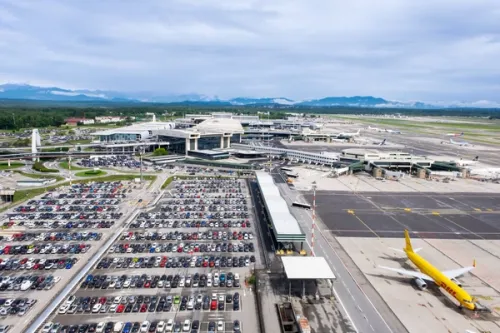
Terminal-to-terminal car shipping



